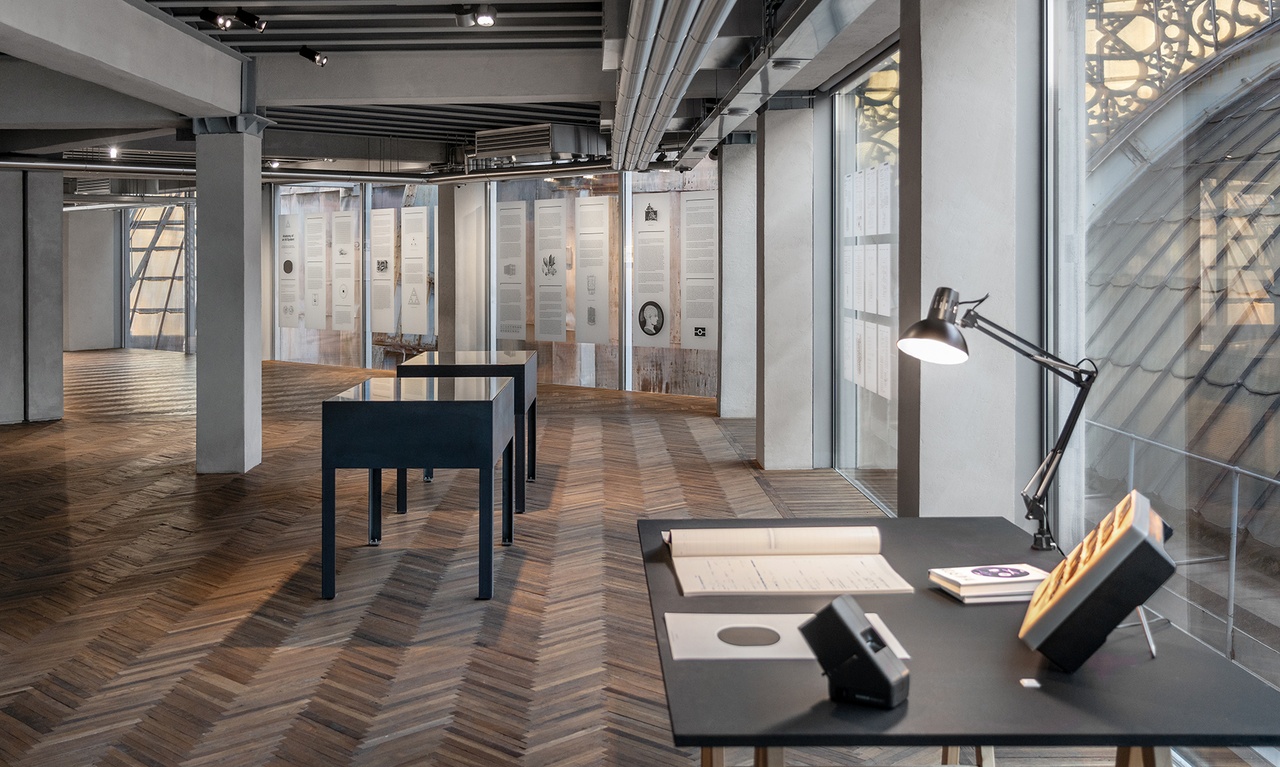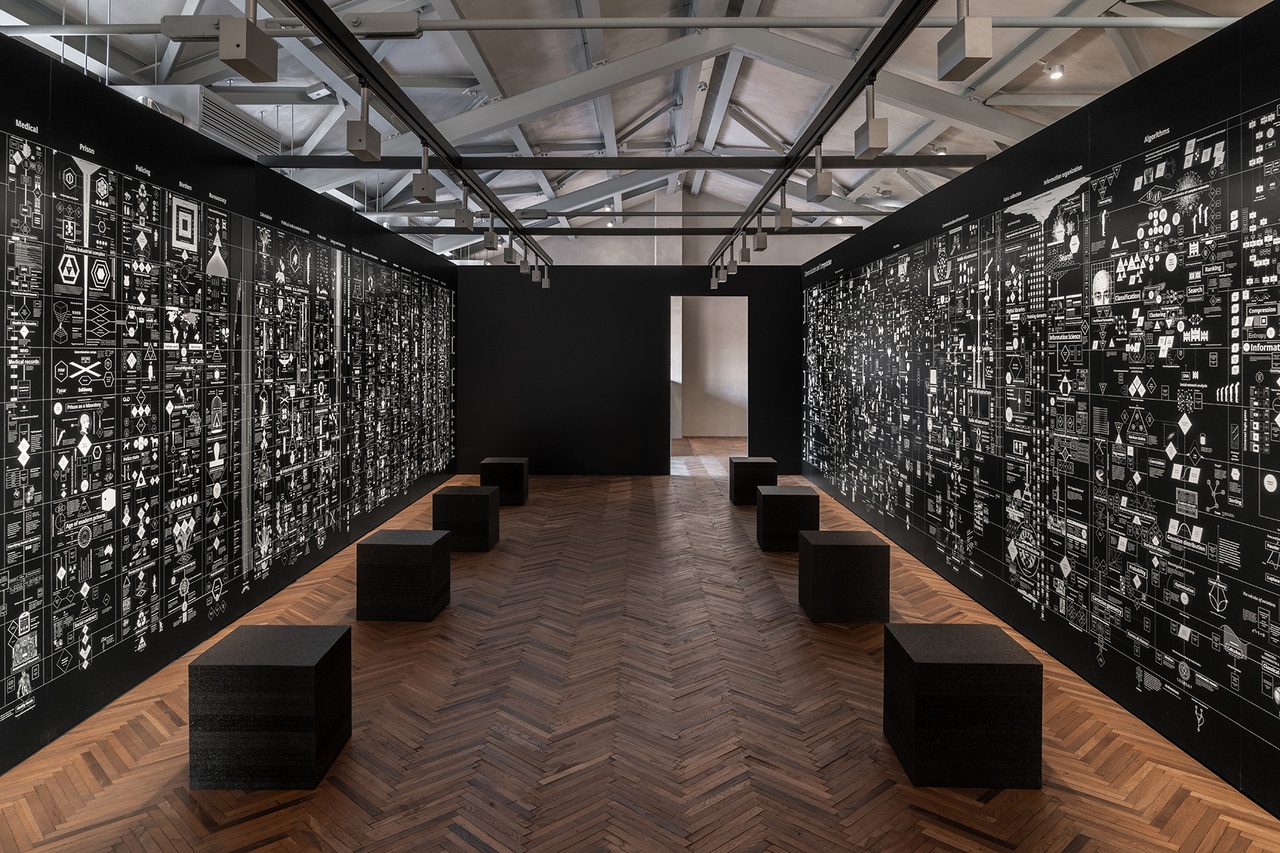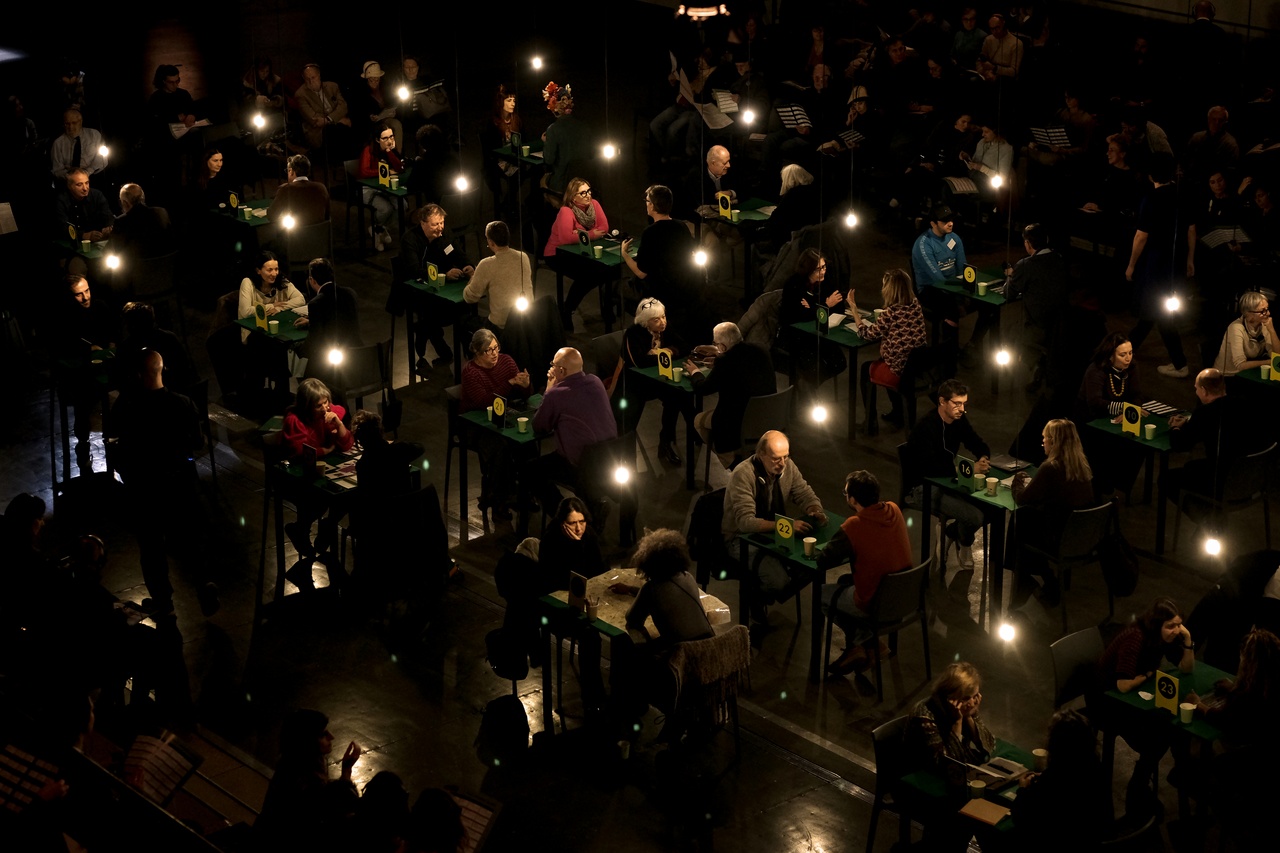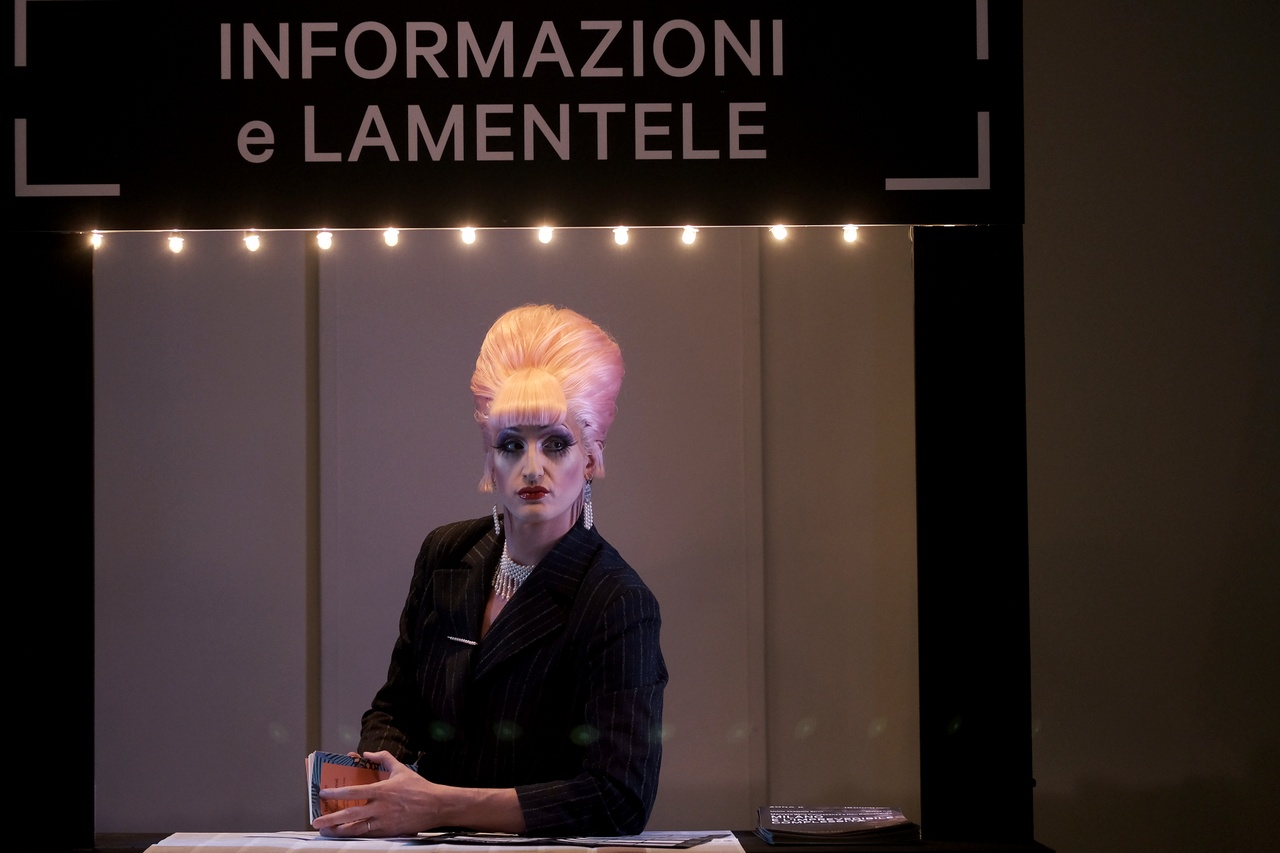MARKET FORCES Claire Bishop on Kate Crawford and Vladan Joler at Fondazione Prada and Hannah Hurtzig at La Pelota, Milan

“Kate Crawford and Vladan Joler: Calculating Empires,” Fondazione Prada, Milan, 2023–24
Research-based art, made by artists specifically for the gallery, can often come across as enthusiastic amateurism – a vomit of undigested print media preciously arranged in vitrines. It’s rarer to find academics transposing their research into artistic formats and forums, and the result can be a refreshing change of pace. On a balmy day in Milan last December, I visited two projects that placed expertise on display, although in very different manners: the exhibition “Calculating Empires: A Genealogy of Technology and Power, 1500–2025,” a collaboration between the Australian scholar of AI Kate Crawford and Serbian artist Vladan Joler, and the participatory performance Market for Useful Knowledge and Non-Knowledge by the German theater-maker Hannah Hurtzig. But if the level of discourse was higher than usual, both projects still encountered the familiar problem of “information overload.” How much material can viewers absorb before they start to feel deluged?
“Calculating Empires,” tucked away in Fondazione Prada’s Osservatorio, continued the institution’s commitment to the intersection of art and science – an uneasy alignment in which science usually ends up having the upper hand. (Remember “Human Brains,” on view at the foundation’s space in Venice during the 2022 Biennale.) The show hovered in a nebulous zone between research project and work of art, to the point where it seemed churlish to make distinctions. It comprised Crawford and Joler’s visualizations of the former’s research; works of art by other tech-minded artists (e.g., Simon Denny); and books and ephemera in vitrines. The centerpiece of the exhibition was the eponymous installation: two long walls of a room within a room were wallpapered with white-on-black timelines charting the history of technology and imperial domination across 525 years. One side was headed “Communication and Computation,” facing off against “Control and Classification” on the other. Minimal captions were interspersed with pictograms and illustrations – think Fornasetti meets Otto Neurath – the most striking of which was an inverted octopus, based on a nineteenth-century lithograph. Its eight twisting legs appeared frequently to indicate multiple strands and tentacular reach, from European colonialism (1500–1700) and “unlimited atrocities” in the colonies (1800s) to technological capture (2012 to now).

“Kate Crawford and Vladan Joler: Calculating Empires,” Fondazione Prada, Milan, 2023–24
Indeed, Crawford and Joler describe their “map” as an attempt to understand our current technological moment – in particular, generative artificial intelligence – as part of a much longer history. Each wall advanced chronologically from floor to ceiling according to topic, and was subdivided horizontally. “Communication devices” (the first column in Communication and Computation) began with heraldry and trumpets at the bottom, telegraphs and phonographs at waist height, transistors and vinyl near my shoulders, MP3s at eye level, and then upward to music platformization, smart speakers, and AI-composed tunes. Shifting a few feet to the right, my gaze ascended from physical inventions – from the printing press to the typewriter to personal computers – to contemporary digital infrastructures such as the World Wide Web and the large language models (LLMs) that define machine learning today.
To my surprise, I found myself reading much more than I had anticipated, my eyes darting from bottom to top, left to right, and zigzagging around. As a dazzling synthesis of history in diagrammatic form, it’s straight-A work. But the priority was nouns rather than verbs; how the different developments related to each other was left ambiguous. The implicit agent was simply … the march of time (progress?). Given the title, I was also hoping for a more decolonial take: the focus is predominantly Western; the chronology is linear. Colonialism was just one of 23 organizing rubrics of Control and Classification, while the adjacent column on capitalism was twice as wide. The presence of non-Western information systems was negligible – I spotted a quipu and the I Ching, but they felt like token addenda. The paradoxical effect, as with many critiques of empire, was to reinforce the object of criticism, rather than to dismantle and reimagine it. A sense of crushing inevitability ensued; the octopus grip of surveillance capture seemed unavoidable.
At the far end of the gallery, behind the main installation, a large table displayed reproductions of the timelines, printed on tracing paper and bound into books. Visitors were encouraged to grab a pencil and get annotating. The resulting comments were an unexpected highlight – never before have I been so relieved to hear from the general public at the end of an exhibition, as their responses introduced some much-needed handiwork and friction. One visitor complained that more audio history was needed and included a bibliographic reference. Another remarked on the rising military use of AI to generate bombing targets, pointing to Israel’s escalated civilian killings in Gaza. In a column on “Interfaces,” between icons representing a mobile phone and chatbots, someone added “Grindr” and “Sexting”; nearby, a different writer appended “Shitposting.” Perhaps as a meta-commentary on the exhibition as a whole, a fifth person circled the first three letters of “Joystick” (patented in 1926) and asked if this had been forgotten.
There’s no exhibition catalogue, so I left “Calculating Empires” with only a thin booklet, which pointlessly reproduces the timelines shrunk down to a height of nine inches, rendering them mostly illegible. By contrast, Crawford and Joler’s previous joint effort, a map of the global resources and networks that undergird the Amazon Echo (Anatomy of an AI System, 2018) is publicly available online (it’s also in the collection of New York’s Museum of Modern Art). This diagram was featured at the Osservatorio along with a striking pair of vitrines holding geological samples of the Echo’s mineral makeup – one of the most visually effective and memorable moments in the show. I would encourage the duo to upload and share the massive timelines of Calculating Empires in the same spirit.

“Hannah Hurtzig: Market for Useful Knowledge and Non-Knowledge,” La Pelota, Milan, 2023
It would be hard to find a more different approach from Crawford and Joler’s crisp, clinical overview than the festive atmosphere of Hannah Hurtzig’s Market for Useful Knowledge and Non-Knowledge, which I attended immediately afterward, at a 1960s sports hall turned event space called La Pelota. In the 1990s, Hurtzig began organizing short-term experimental “academies” on various evocative topics, such as urban folklore and the undead. (Indeed, she still works with collaborators under the dry moniker Mobile Akademie Berlin.) For the Market, first staged in 2005 and traveling across Europe ever since, Hurtzig condensed the weeks of school into a single evening and contracted each class to one student: fifty to a hundred “experts” sit at small tables and engage in half-hour, one-to-one conversations with audience members, who sign up and pay one euro for the opportunity. Visitors can also sit on bleachers along the sides of the central arena, with the option to listen via headphones to select conversations that are broadcast live.
Each Market has its own site-specific thematic umbrella, and the curated experts include academics and amateurs well-versed in related topics, all summarized in a handout labeled “Encyclopedia.” (These days, Hurtzig licenses the Market to other curators to organize and choose the experts, following her framework and specifications; the Milan edition was curated by the directors of Zona K, the cultural organization that produced the event.) The Market I attended was on the somewhat broad and quizzical subject of “Milan and the Unpredictable.” I spoke first with a management consultant who deploys mosaic art to explain organizational complexity to his clients. I was intellectually underwhelmed. An hour later, I sat opposite a young trans stand-up comedian (the only one in Italy!), who presented himself as an expert on transitioning in Milan. Our tête-à-tête was candid and wide-ranging, as opposed to the opaque mystifications of the consultant, and better fulfilled the Market’s capacious approach to expertise.
In the end, Hurtzig’s Market is less an educational opportunity and more a theatricalization of what used to be called “knowledge transfer” (shudder). A cursory glance at the Encyclopedia quickly establishes that the expertise on offer adds up to a sprawling, idiosyncratic take on a subject rather than a comprehensive overview. Plus, any one audience member gains a limited perspective, encountering at most six experts over the course of the three-hour event – a modest slice of the dozens actually present.
By foregrounding a claim of usefulness, Hurtzig distracts from the fact that her Market flirts with excess. Each one is unique, requiring months of research, and the assembly of experts come together for one night only – a proportionality that flouts any rational logic of investment, in either effort or money. (Aside from that one-euro fee to chat with an expert, the event is free to the public.) And while a handful of conversations from every Market are accessible via an online audio archive, I honestly can’t imagine anyone listening to them outside the context of the live event.
Instead, the Market’s value seems to lie in the sociality engendered by the overall spectacle and odd pleasures of the staging conceived by Hurtzig, whose dramaturgical background is apparent in the lively pace and many creative details. The structure and aesthetic are always the same: Each two-person table is topped with green baize and lit by a single low-hanging bulb; the lights flicker and a gong bongs to cue the start of each session. Hosts and hostesses wear matching uniforms and thick ’80s-style makeup as they assist at the check-in booths or hold up handmade placards with wry aphorisms (in Milan: “The future is already here, it’s just badly distributed”). I visited a complaints booth staffed by a pink-wigged drag queen, who listened to my gripes about the limited food options at the event and offered a shot of vodka as consolation. Although attendance tailed off in the last hour, the performance had all the buzz and excitement of any good marketplace.

“Hannah Hurtzig: Market for Useful Knowledge and Non-Knowledge,” La Pelota, Milan, 2023
If the Market for Useful Knowledge and Non-Knowledge was initially imagined as a tongue-in-cheek response to the neoliberal imperative to self-market and the demand that scholarship (and culture) be demonstrably utilitarian, then “Calculating Empires” reads as a more focused and sober rejoinder to the commodification and privatization of knowledge. But while the former assumes information is lived and relayed in a slew of haphazard ways, the latter takes it as something to decipher, tidy, and organize. And yet to place these works in a framework invoking knowledge production feels outdated today. The more timely point of reflection is to read both projects against the growing presence of artificial intelligence.
Crawford has written at length about the exponential speed of AI innovation and its impact, decrying the concentration of power in the hands of a few tech companies, pointing out troubling shifts in human labor and creative work, and warning of the dangers of AI development without strict governmental regulation. Yet none of this polemic gets expressed in her and Joler’s map. Ironically, “Calculating Empires” appeared to offer a calming riposte to the current fearmongering, presenting AI as just one more technological leap – algorithmically generated tunes as the benign descendent of the trumpet.
Perhaps Hurtzig’s Market provides a better counter, centering human exchange as unscripted and contingent, much like the event itself. (In Milan, a group of evangelical Christians infiltrated the event and booked experts in hopes of proselytizing.) It was the perfect complement to “Calculating Empires,” as well as to the very idea of predictive language generation: a playful reminder of the pleasures and awkwardnesses of human communication – in short, the refreshingly unpredictable nature of embodied intelligence.
“Kate Crawford and Vladan Joler: Calculating Empires: A Genealogy of Technology and Power, 1500–2025,” Fondazione Prada, Milan, November 23, 2023–January 29, 2024.
Hannah Hurtzig’s Market for Useful Knowledge and Non-Knowledge, La Pelota, Milan, December 17, 2023.
Claire Bishop is Presidential Professor in the PhD Program in Art History at the Graduate Center, City University of New York.
Image credit: 1. + 2. Courtesy Fondazione Prada, photos Piercarlo Quecchia – DSL Studio; 3. + 4. Courtesy Zona K, photos Davide Stecconi
